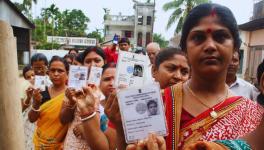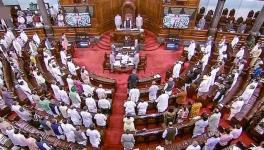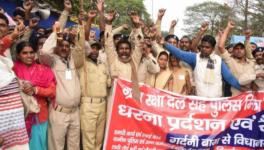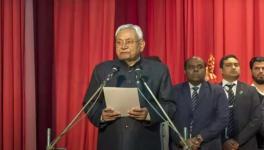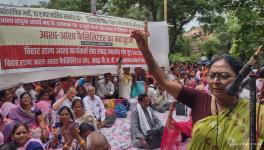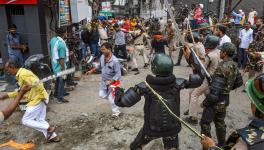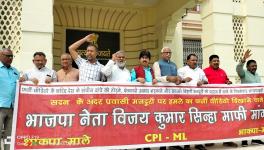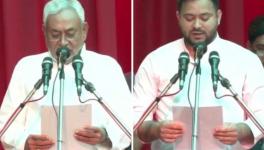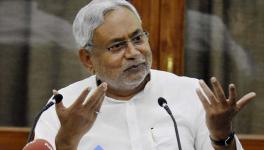Shadow of Laxmanpur Bathe on Bihar Election
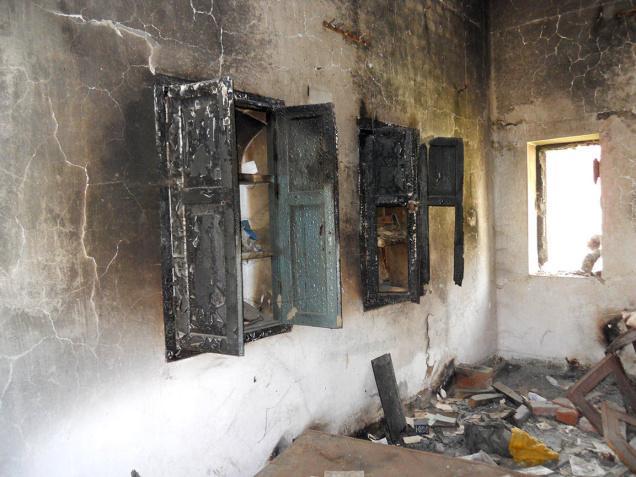
The outlawed Ranvir Sena—the private army of upper caste landlords of Bihar—is in the news again. It recently threatened the Bihar chief of the Bhim Army, Gaurav Siraj, and one of its activists, Ved Prakash, through a Facebook post. The so-called army has “ordered” its “sainiks” to “arrest” him dead or alive. The sena is apparently peeved over how the young dynamic leader of the Ambedkarite organisation has described Brahmeshwar Singh, their slain “Mukhiya” who was killed in 2012.
Will there be any action against those who have threatened the young leader? If history is any guide then there is little possibility of this.
Merely two years ago, Nawal Kishor Kumar, who is Editor Hindi, Forward Press, was targeted by this "sena" The aggrieved journalist had lodged a police complaint but there has been no progress in the investigation.
It is not that there is no law to punish such miscreants. Social media posts of the threatening kind relate to various offences under the Indian Penal Code, from criminal intimidation punishable under section 503 to section 505 related to creating mischief in public, to section 506 which awards punishment for criminal intimidation and section 153A which relates to penalties for promoting enmity between different groups and so on. In fact, based on its activities, the Ranvir Sena is also liable to be prosecuted under section 3 of the Bihar Control of Crimes Act, section 3 of the Arms Act and section 3 of the Scheduled Castes and Scheduled Tribes (Prevention of Atrocities) Act, 1989.”
The Ranvir Sena’s association with the Bhumihars, a dominant and land-owning caste in Bihar, is what gave it its clout, and no doubt it still wields some weight on that basis. Perhaps that is why a Member of Parliament, who was a Cabinet minister during Prime Minister Narendra Modi’s first term—Giriraj Singh—recently referred to Brahmeshwar Singh as a “martyr” in a social media post.
Giriraj Singh was forced to delete the tweet after it caused a tremendous uproar in the Opposition camp, but he is certainly not the only one who is fascinated by Brahmeshwar Singh and his deeds. A significant section of the elite castes, especially the politically powerful Bhumihars—still consider him an icon. They celebrate the day he was killed as “martyrdom day”, on which occasion even newspapers covering developments in Bihar fall over each other to cover its proceedings.
The banned outfit was implicated in brutal massacres of the downtrodden, many of whom were close supporters of left outfits. In fact, the sole aim of this so-called sena was to crush the CPI(ML) and other revolutionary groups that sought economic justice and social respect for the deprived. In this task, the Ranvir Sena received state patronage at every level. A report of the Human Rights Watch said in 1999, “Broken People: Caste Violence Against India’s Untouchables” explained the inner workings of the phenomenon. “The extent of political patronage extended to the Ranvir Sena can be gauged by the fact that while a large number of Naxalites are killed in “encounters” [with police] not a single Ranvir Sena man has been subjected to this fate. The administration awakes a little later when it comes to tackl[ing] these armies. The outfit [Ranvir Sena] had declared a few days before the Jehanabad carnage that it would soon make a national and international headline.”
A close scrutiny of the thirty massacres involving Ranvir Sena makes it clear how it “targeted women and children because they believed the women give birth to Naxals and the children become Naxalites when they grow up.” About 300 deaths, mostly of poor peasants and agricultural labourers, mostly dalit and backward caste members, are said to be this army’s legacy over the six years after it was set up in September 1994.
The sudden visibility of the sena is a cause for concern considering that the elections to the Bihar Assembly are due and the JD(U), LJP and the BJP-led coalition government are facing flak for their inept handling of the Covid-19 emergency and the economy, and when the BJP is in any case on the defensive because of the Galwan episode.
Should Giriraj Singh’s statement and the threat to the Bhim Army be seen as a signal to the upper castes as to what they should do in the coming elections and who they can consider the defender of their interests? Is there a sinister design at work wherein the sena’s network of activists and sympathisers are going to “fight” the anti-incumbency faced by the ruling coalition? All we know is that there is enough information in the public domain about the proximity of ruling party leaders with this once-dreaded outfit.
In a sting operation in 2015, the investigative news portal Cobrapost had caught six hardened Ranvir Sena killers admitting to their crimes . The sena members had named a former prime minister and many leading politicians of the BJP as their helpers. They admitted their role in the massacre of 144 destitute Dalits at Bathani Tola, Laxmanpur Bathe, Shankar Bigha, Miyanpur and Ikwari and revealed that they had been trained by retired or on-leave army jawans. They also referred to the disbanding of the Amir Das Commission and how its probe into the Sena’s modus operandi was skilfully scuttled.
There was, as a matter of fact, nothing “new” in this expose. It simply reiterated things that were already known about the sena.
The Justice Amir Das Commission was disbanded by Nitish Kumar when he became Bihar Chief Minister in 2004. Appointed by the Lalu Prasad Yadav-led government in 1997 after the Laxmanpur Bathe massacre, the commission is said to have unearthed details about the patronage the outfit got from mainstream political organisations, including funding and logistical support.
A September 2016 PUDR report, “Harvesting Death: Massacres in Bihar and the Question of Justice”, cites an April 2006 CNN-IBN report on the disbanded commission. The news report claimed, apparently on the basis of a leaked copy of the incomplete report, that the commission was going to name 37 politicians. (Justice Amir Das (retired) told reporters after his commission was disbanded that his findings would have to be categorised as “inconclusive”.)
Citing the CNN-IBN news report, the PUDR report says, “The Commission report reportedly named CP Thakur as having attended meetings of the Ranvir Sena in 1997, ahead of the Haibaspur massacre...and of being close to the Sena supremo, Brahmeshwar Mukhiya. According to the news story, BJP national leader Murli Manohar Joshi had threatened the officer charge of Paliganj Police Station (PS) of repercussions to prevent him from taking action on the Haibaspur massacre.
“A number of other politicians were reported as having sought the blessings of the Sena during the elections. These include the state-level leader of the BJP Sushil Kumar Yadav as well as Akhilesh Singh and Kanti Singh (both in the RJD). Others mentioned in the news story are Shivanand Tiwari, Ram Jatan Sinha and Nand Kishore Yadav.”
The fact remains that despite these revelations, which ought to have become sources of further investigation, barring a few exceptions, none of the members of this sena was convicted by the higher courts even though the lower courts had found them guilty. The Patna High Court acquitted 9 out of ten accused in the Miyapur massacre for “lack of evidence”, overturning a lower court’s order in July 2013.
The Miyapur massacre was a major carnage in which the Ranvir Sena had killed 32 people, mostly Dalits, supposedly to avenge an earlier Naxal attack in Senari village of Jehanabad. About 400-500 people had entered the village and fired at the villagers on 16 June 2000. The same year, the Patna High Court overturned another judgement by a lower court where 11 persons accused of killing ten CPI(ML) activists in November 1998 had been convicted. The reversal in the Bathani Tola massacre verdict—which involved 23 accused—and the Laxmanpur Bathe massacre in which 58 died, are now known to all.
The PUDR report presented a summary of four cases involving the Ranvir Sena’s marauders and explained how such acquittals took place for “lack of evidence”. A close reading of the cases makes it clear that loopholes were deliberately left in these cases which led to the accused going free. For example, the police had pronounced Brahmeshwar Singh, the prime accused, as an “absconder” in one case, but at the time he had been languishing in Ara jail.
After he was out of jail—without having been convicted—Brahmeshwar Singh had launched a peasant organisation named Akhil Bharatiya Rashtravadi Kisan Sangathan to help him deftly project himself as a peasant leader. The brutal sena he had set up does not just exist today. It is reportedly active as well. An unpredictable element has found a new lease of life, thanks to the coming election, and what the future holds few can tell.
The author is an independent journalist. The views are personal.
Get the latest reports & analysis with people's perspective on Protests, movements & deep analytical videos, discussions of the current affairs in your Telegram app. Subscribe to NewsClick's Telegram channel & get Real-Time updates on stories, as they get published on our website.









